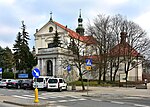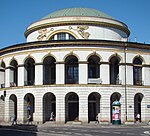Maria Konopnicka Monument
1966 establishments in Poland1966 sculpturesBuildings and structures completed in 1966Monuments and memorials in WarsawMonuments and memorials to women ... and 7 more
Outdoor sculptures in WarsawSculptures of women in PolandStatues in PolandStatues of womenStatues of writersStone sculpturesŚródmieście Północne

Maria Konopnicka Monument (Polish: Pomnik Marii Konopnickiej) is a syenite statue in Warsaw, Poland, within the Saxon Garden in the Downtown district. It is dedicated to Maria Konopnicka, a 19th- and 20th-century poet, novelist, children's writer, and activist for women's rights and the independence of Poland. It was designed by Stanisław Kulon, and unvailed on 22 May 1966.
Excerpt from the Wikipedia article Maria Konopnicka Monument (License: CC BY-SA 3.0, Authors, Images).Maria Konopnicka Monument
Marszałkowska, Warsaw Midtown
Geographical coordinates (GPS) Address External links Nearby Places Show on map
Geographical coordinates (GPS)
| Latitude | Longitude |
|---|---|
| N 52.2415 ° | E 21.005916666667 ° |
Address
Pomnik Marii Konopnickiej
Marszałkowska
00-102 Warsaw, Midtown
Masovian Voivodeship, Poland
Open on Google Maps











